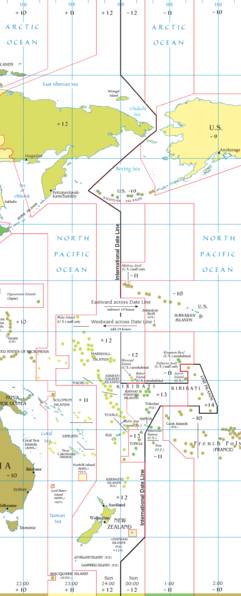Do We Really Need a Date Line?
In discussing the Sabbath, especially in the South Pacific, folks frequently question how it can be God’s holy 7th day on one island, while the first day of the week, for instance, is taking place on a nearby island at the same time. Most of us probably understand that, when we cross the International Date Line, we are considered to be moving from the day we were on, to a day one day earlier or one day later than before, depending on our direction of travel. However, we also know that God did not directly place the IDL where it is, so how can we use it when deciding which day is God’s holy Sabbath?
Some people have gone so far as to suggest that the Samoan Sabbath Dilemma is all because of the date line, because it is man-made. Se, do we really need a date line, or can we just do away with it?
As we all learned in school, day and night on Earth are the result of the earth rotating on its axis once every 24 hours. The sun is more or less on one side of the earth, so as the earth turns, our spot on its surface alternates between spending time on the sunlit side (daytime) and spending time on the shady side (nighttime).
Here is an animated illustration showing the earth turning on its axis. If you look closely at the right side of the illustration, you can see the sunset moving from east to west across the surface of the earth. This is a continuous motion of the sunset around the world. Wherever we are on the earth, whenever the sun sets, beginning a new day by biblical reckoning, it will set again in another 24 hours to begin yet another day.
But here is a question:
When Thursday sunset is circling the globe, how and when does it become Friday sunset? Since each day is only 24 hours long, such a change must take place once for every rotation of the earth on its axis, but how and when does this happen? When sunset comes to us wherever we are, what determines whether it is still a Thursday sunset or whether it is now a Friday sunset and time for the Sabbath to begin? That’s why there has to be a date line somewhere.
Another way to see the necessity of a date line is to picture traveling westward around the world, leaving a friend at home. Every time you cross into another time zone, you have to set your calendar watch one hour earlier. Without a date line, by the time you get back home, your watch will show a time 24 hours earlier than the time kept by your friend who stayed home.
In essence, this is what actually happened to Magellan’s crew. No, they didn’t have calendar watches and time zones, but they kept meticulous count of the days, and by their reckoning it was Wednesday upon their return to Portugal, whereas it was actually Thursday. So there must be a date line somewhere, where the westward traveler can jump ahead by one day.
You may have noticed that the International Date Line is not a straight line. This is because, not only did God not tell us where it should be, but neither is it determined by any international convention or agreement. Each country decides for itself which reckoning to use, thus determining on which side of that country the IDL shall pass. Even if the IDL were a straight line, sunset would rarely come to it all at once. To show you why, here is an illustration of the seasonal changes in the angle of sunset across the earth.
Whether or not this is the best way for the world to set the date line in place, we can see that, wherever it is located, it will always be one day on one side of the line and the next day on the other side. Thankfully, when we wish to use the International Date Line for our Sabbath keeping, it is as simple as accepting the local reckoning of the days wherever we are. (Also see “Where Did We Get Our International Date Line.”)


Comments
Do We Really Need a Date Line? — No Comments
HTML tags allowed in your comment: <a href="" title=""> <abbr title=""> <acronym title=""> <b> <blockquote cite=""> <cite> <code> <del datetime=""> <em> <i> <q cite=""> <s> <strike> <strong>